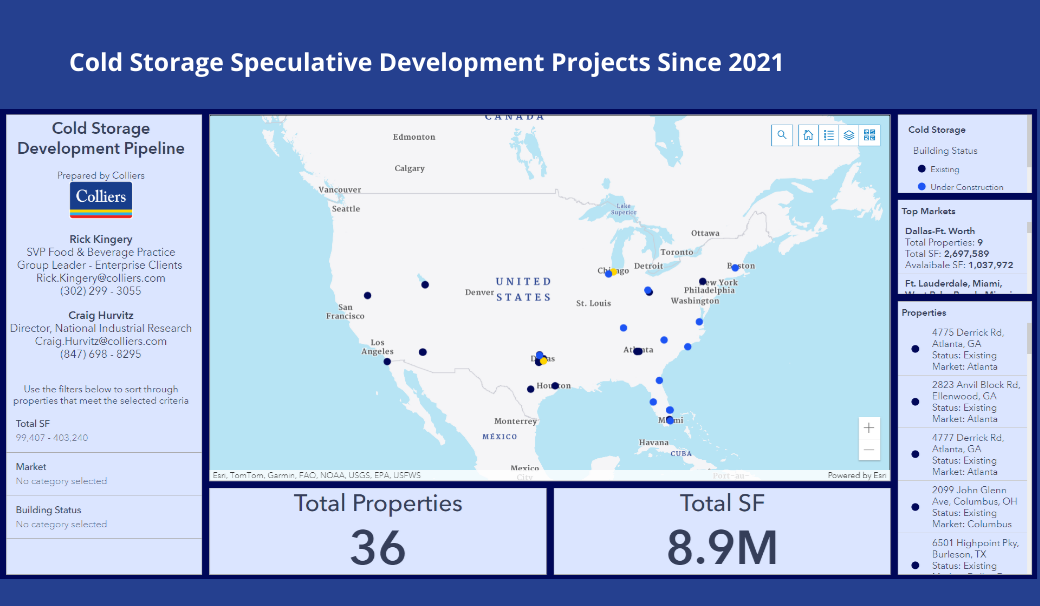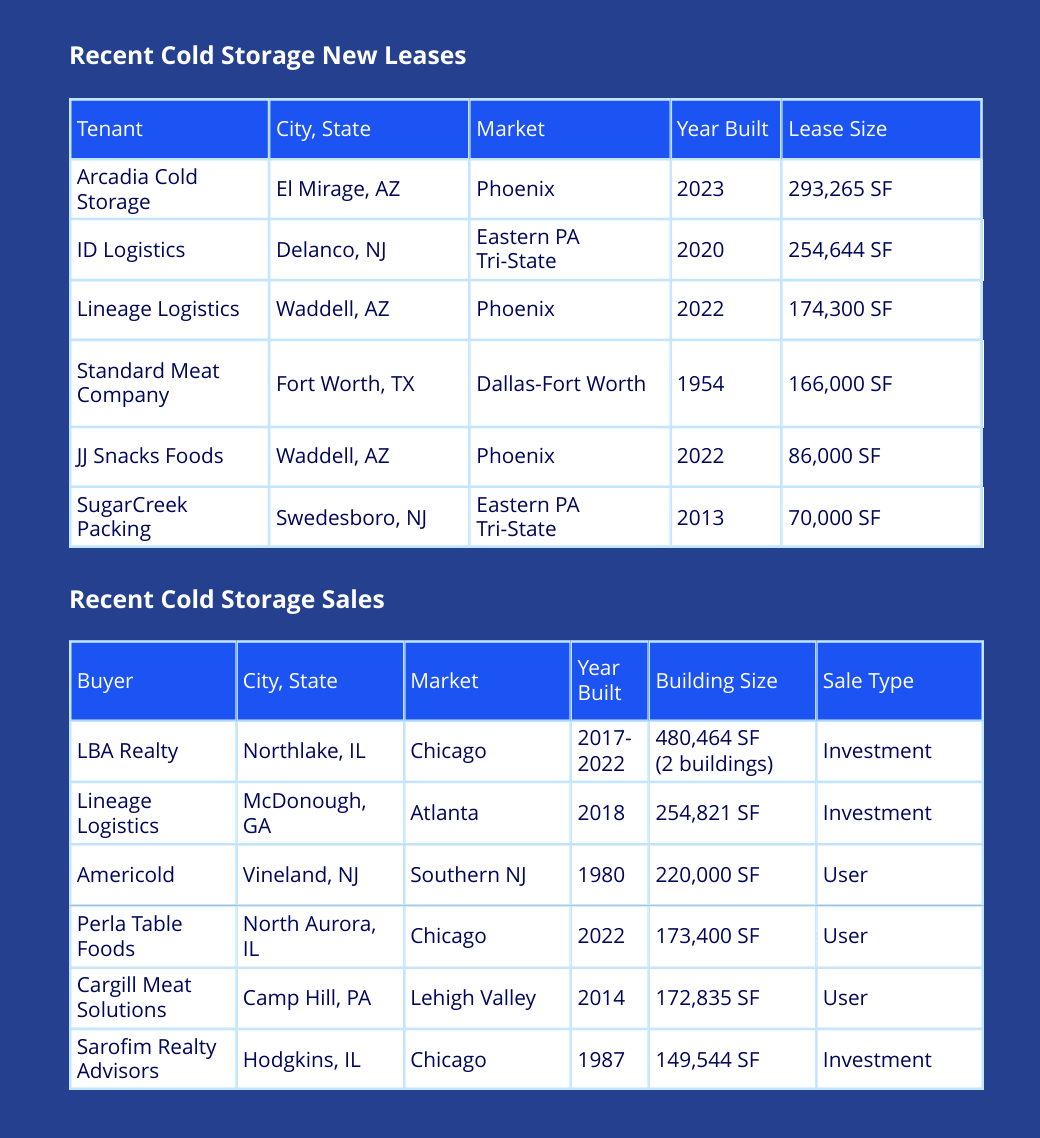Much of the existing cold storage product in the U.S. has aged past its prime — the average age of cold storage buildings in the nation’s top markets is 31 years old. Yet, vacancy rates for the niche product type have continued to fall, dropping to 3.4% in the first half of 2024. Developers have responded, building both build-to-suit projects for cold storage users and cold storage facilities on a speculative basis — a property type that historically wasn’t built without a tenant lined up. For the following study, Colliers defined cold storage as a building 50,000 SF or larger where 60% of the building is cold/frozen, and identified the cold storage inventory in five of the country’s largest cold storage markets — Chicago, Philadelphia, Dallas-Fort Worth, Atlanta and Phoenix.

Cold storage facilities tend to cluster around ports, food manufacturers, and population clusters:
- Proximity to Ports: Ports serve as major entry and exit points for imported and exported goods, including perishable items. Cold storage facilities located near ports facilitate efficient handling and distribution of goods, reducing transportation costs and time. This proximity enables faster turnaround times for imported products needing refrigeration and ensures freshness for exported perishable goods.
- Supporting Food Manufacturers: Cold storage facilities are essential for food manufacturers to store raw materials, intermediate products, and finished goods at controlled temperatures. By locating near food manufacturing hubs, cold storage facilities can provide timely and convenient services to support production processes. This proximity also fosters collaboration and integration within the food supply chain.
- Access to Population Centers: Population clusters represent significant consumer markets with high demand for perishable goods such as fresh produce, meat, and dairy products. By situating cold storage facilities close to these population centers, distributors can streamline their operations and reduce transportation costs associated with delivering goods to retail outlets and consumers. Additionally, proximity to consumers allows for faster delivery times, ensuring product freshness and meeting customer expectations.

Top Cold Storage Markets
Vacancy rates and building age vary among the top cold storage markets surveyed in this study. Chicago — the largest market at 28.3 million square feet — recorded a vacancy rate of only 0.8% in the first half of 2024, and its cold storage inventory is also the oldest, averaging 43 years old. On the other hand, Atlanta’s cold storage vacancy rate was 11.9%, while the average age of its cold storage product was 28 years old. Each market boasts unique attributes due to location or population growth that make it a hotbed for cold storage users.
Chicago – Food Manufacturing Hub
Approximately 4,500 food and beverage manufacturing companies thrive, and the demand for cold/frozen storage vastly outstrips available space.
Philadelphia – Port Activity
The Delaware River port community, encompassing Pennsylvania, New Jersey, and Delaware, plays a significant role in the food import market, with a total value of $6.6 billion, wherein fruits and vegetables contribute over $4 billion. Refrigerated containers account for 54% of the port volume, and PhilaPort’s container volumes have displayed an impressive growth.
Dallas – Population Growth
Over 8.1 million people now call the Dallas-Fort Worth Metroplex home after the region experienced the largest population growth of any metropolitan area in the country in 2023, according to the U.S. Census.
Phoenix – Booming Population and Reasonable Land Pricing
Phoenix added 195,000 people between 2020 and 2023, according to new estimates from the Census Bureau released Thursday. The big picture: The influx of newcomers represented a 4% population increase. Additionally, distribution from Phoenix can reach a number of metros while the land prices are still at a “reasonable” price point and have availability.
Atlanta – Food Manufacturing Hub
Georgia boasts 1,440 food processing businesses and has a Food & Beverage Industry GRP of $11.B. Georgia, known as the poultry capital of the world, exports over $1.5 billion annually to domestic and global markets. Poultry exports surged by 29% from 2021 to 2022, marking a nearly $350 million increase in just one year.
Cold Storage Speculative Development
Low vacancy rates and growing demand for cold storage facilities have pushed developers to build cold buildings on a speculative basis for the first time. 21 spec cold storage buildings totaling 5.6 million square feet have been built since 2021, and another 15 buildings totaling 3.4 million square feet are currently under construction or about to begin. These buildings have been built by less than 20 developers that specialize in the product type, and feature ceiling clear heights 36’ to 50’, heavy power requirements, wide internal temperature ranges, and specialty reinforced floor slabs.

Click here for an interactive map of speculative cold storage projects built since 2021, under construction or about to begin construction.



 Rick Kingery
Rick Kingery Craig Hurvitz
Craig Hurvitz Ronna Larsen
Ronna Larsen

 Baily Datres
Baily Datres Mike Otillio
Mike Otillio
 Jesse Tollison
Jesse Tollison
 Patrich Jett
Patrich Jett